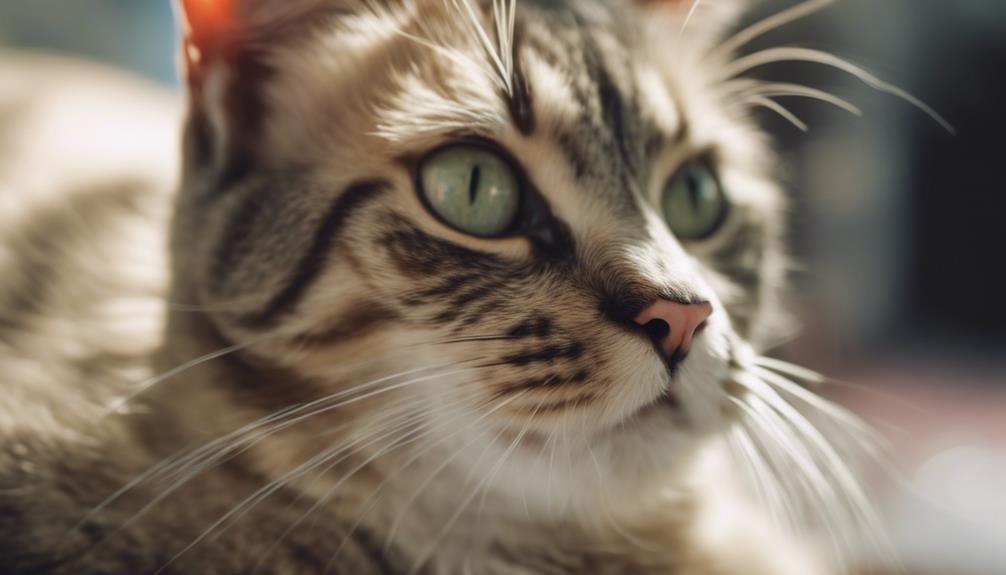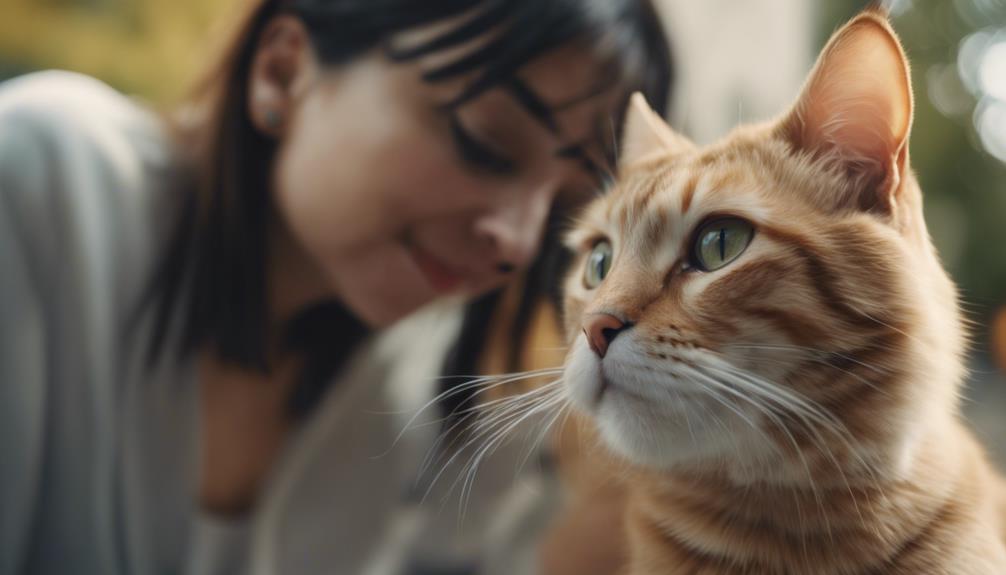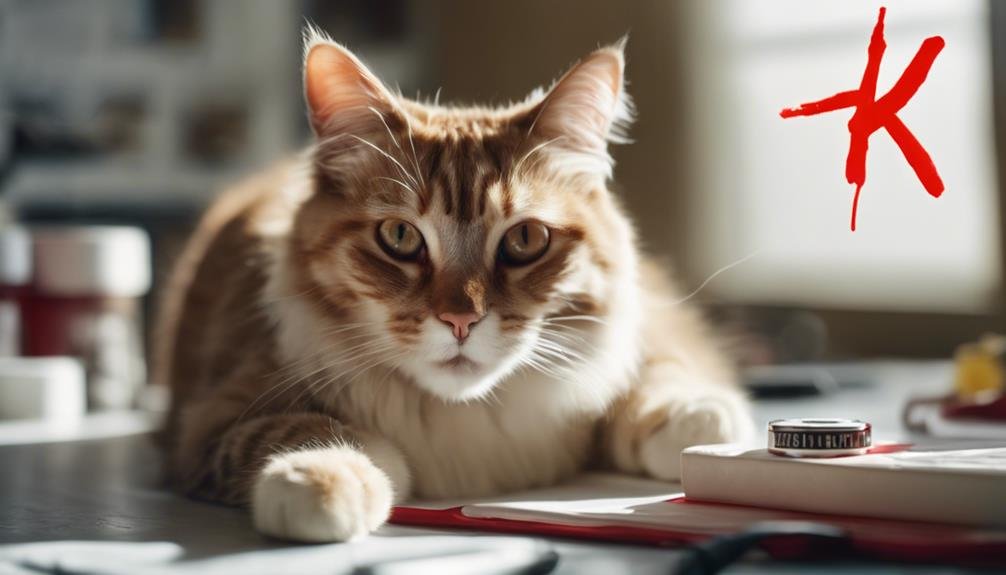Exploring the intricacies of cats' reproductive cycles unveils intriguing insights into the feline world. The question of whether cats experience periods may surprise many, but the reality is more nuanced.
A veterinarian's perspective sheds light on this matter, offering a unique perspective on how cats' estrus cycles diverge from conventional menstruation. Understanding these distinctions is not only fascinating but also essential for responsible pet care.
To unravel the mysteries of feline biology and behavior, let's delve deeper into the topic of cats and their unique reproductive patterns.
Key Takeaways
- Female cats do not have menstrual periods but go through an estrus cycle.
- Cats are induced ovulators, needing male stimulation to ovulate.
- Spaying before the first heat cycle is recommended for female cats' health.
- Cats in heat show behavioral signs like seeking out males and increased affection.
Female Cats' Reproductive Cycles
Female cats' reproductive cycles differ significantly from those of humans and other animals, as they do not have menstrual periods but instead go through an estrus cycle. During this cycle, female cats exhibit signs of being in heat, such as producing special pheromones, seeking out males, and showing increased affection. Cats are induced ovulators, meaning they require stimulation by a male cat to ovulate.
This cycle can start as early as 4 months old in young female cats and ends after mating and ovulating. Unspayed female cats can experience hormonal surges every two weeks without breeding. Spaying before the first heat cycle is advised to reduce the risk of breast cancer and prevent unwanted pregnancies. Consulting a vet for guidance on cat reproductive health is recommended.
Estrus Cycle in Cats
Induced ovulation characterizes the estrus cycle in cats, a distinct reproductive phenomenon that sets them apart from other mammals. Unlike animals with regular menstrual cycles, female cats do not experience bleeding but instead display behavioral changes when in heat.
The estrus cycle typically begins as early as 4 months old in young female cats, continuing until mating and ovulation occur. Unspayed female cats can undergo hormonal surges every two weeks if not bred, highlighting the importance of spaying to prevent potential health issues.
Spaying before the first heat cycle is advised to reduce the risk of breast cancer. Understanding the unique estrus cycle of cats is crucial for responsible pet ownership and promoting feline well-being.
Behavioral Signs of Cats in Heat

In understanding the behavioral signs of cats in heat, it becomes apparent that these felines exhibit distinct changes indicative of their reproductive readiness. During this time, female cats may display heightened restlessness, vocalization, and a strong desire for attention. They might rub against objects, roll on the floor, and assume a mating position when petted.
Female cats in heat may also become more affectionate, seeking out interaction with both humans and other cats. Additionally, they release special pheromones to attract potential mates. Understanding these behavioral cues can help cat owners recognize when their feline companions are in heat, allowing for appropriate management and care during this reproductive phase.
Health Benefits of Spaying Cats
Spaying cats provides significant health advantages, contributing to their overall well-being and longevity.
- Reduces the risk of uterine infections
- Prevents the development of uterine and ovarian cancers
- Decreases the likelihood of mammary gland tumors
- Helps control behavioral issues related to mating instincts
Cats' Perception of Owners

Cats demonstrate a keen perception of their owners' emotional states and behaviors. These intuitive animals often pick up on subtle cues, offering comfort and companionship during times of distress. While there is no concrete evidence that cats can detect menstrual cycles, they have been observed to provide extra purrs and affection when their owners are feeling down or unwell.
Cats are known for their ability to sense changes in mood and behavior, responding with increased attention and support. This innate sensitivity to human emotions highlights the unique bond between cats and their owners, creating a source of solace and companionship in various life situations.
Emotional Support From Cats
During times of emotional distress, feline companions often exhibit remarkable sensitivity and intuitive responses towards their owners' needs. Cats have a unique way of offering emotional support, which can be truly comforting. Here are some ways they show their support:
- Extra Purrs and Snuggles: Cats may offer more affectionate gestures like purring and snuggling when their owners are feeling down.
- Intuitive Comfort: Cats can sense changes in behavior or mood and respond by providing comfort and companionship.
- Responsive to Emotional Needs: These intuitive animals are known to be responsive to their owners' emotional needs, offering a sense of security and warmth.
- Companionship in Distress: Cats are there for their owners during tough times, offering a calming presence and emotional support.
Importance of Spaying Female Cats

Feline companionship during challenging times extends beyond emotional support; understanding the significance of spaying female cats is crucial for their long-term health and well-being. Spaying female cats before their first heat cycle is highly recommended by veterinarians for various reasons, including reducing the risk of breast cancer and preventing unwanted pregnancies. Below is a table summarizing the importance of spaying female cats:
| Importance of Spaying Female Cats | |
|---|---|
| Reduces risk of breast cancer | |
| Prevents unwanted pregnancies | |
| Promotes long-term health | |
| Helps control cat population | |
| Consult a vet for spaying advice |
Consultation With a Veterinarian
When seeking advice on cat reproductive health, consulting with a veterinarian is essential for accurate information and tailored recommendations.
- Veterinarians provide personalized insights into your cat's reproductive health.
- They can offer guidance on spaying and the importance of early intervention.
- Vets help monitor your cat's overall well-being during different reproductive stages.
- They can address any concerns or questions regarding your cat's estrus cycle.
Frequently Asked Questions
Can Female Cats Get Pregnant Without Going Into Heat?
Without going into heat, female cats cannot get pregnant. Heat, or estrus, is a crucial phase for ovulation and mating to occur. Spaying before the first heat cycle is vital to prevent unwanted pregnancies and maintain feline health.
Do All Female Cats Exhibit the Same Behaviors When in Heat?
While all female cats experience heat cycles, not all exhibit the same behaviors. Factors like breed, environment, and individual personality can influence how a cat behaves when in heat. Consulting a vet for personalized advice is recommended.
Can Spaying a Female Cat Affect Her Personality or Behavior?
Spaying a female cat before her first heat cycle can positively impact her health and prevent unwanted pregnancies. While some owners report minor behavior changes post-spaying, the benefits of the procedure in terms of health and population control are widely recognized.
How Long Does a Typical Estrus Cycle Last in Female Cats?
A typical estrus cycle in female cats usually lasts around 7-10 days, but it can vary. During this time, cats exhibit behaviors indicating they are in heat and seeking a mate. Spaying before their first cycle is recommended for their health.
Are There Any Natural Methods to Help Calm a Cat in Heat Without Spaying?
When seeking to calm a cat in heat without spaying, methods such as providing a quiet, comfortable environment, using interactive toys for distraction, and increasing playtime can help manage behavioral changes. Consulting a vet for guidance is essential.
Conclusion
In conclusion, understanding the unique aspects of female cats' reproductive cycles, including the estrus cycle and induced ovulation behavior, is essential for their health management. Spaying female cats before their first heat cycle not only reduces the risk of breast cancer but also helps prevent hormonal surges.
Cats' perception of their owners and their ability to provide emotional support highlights the strong bond between felines and humans. Seeking advice from a veterinarian is crucial for proper feline care.




